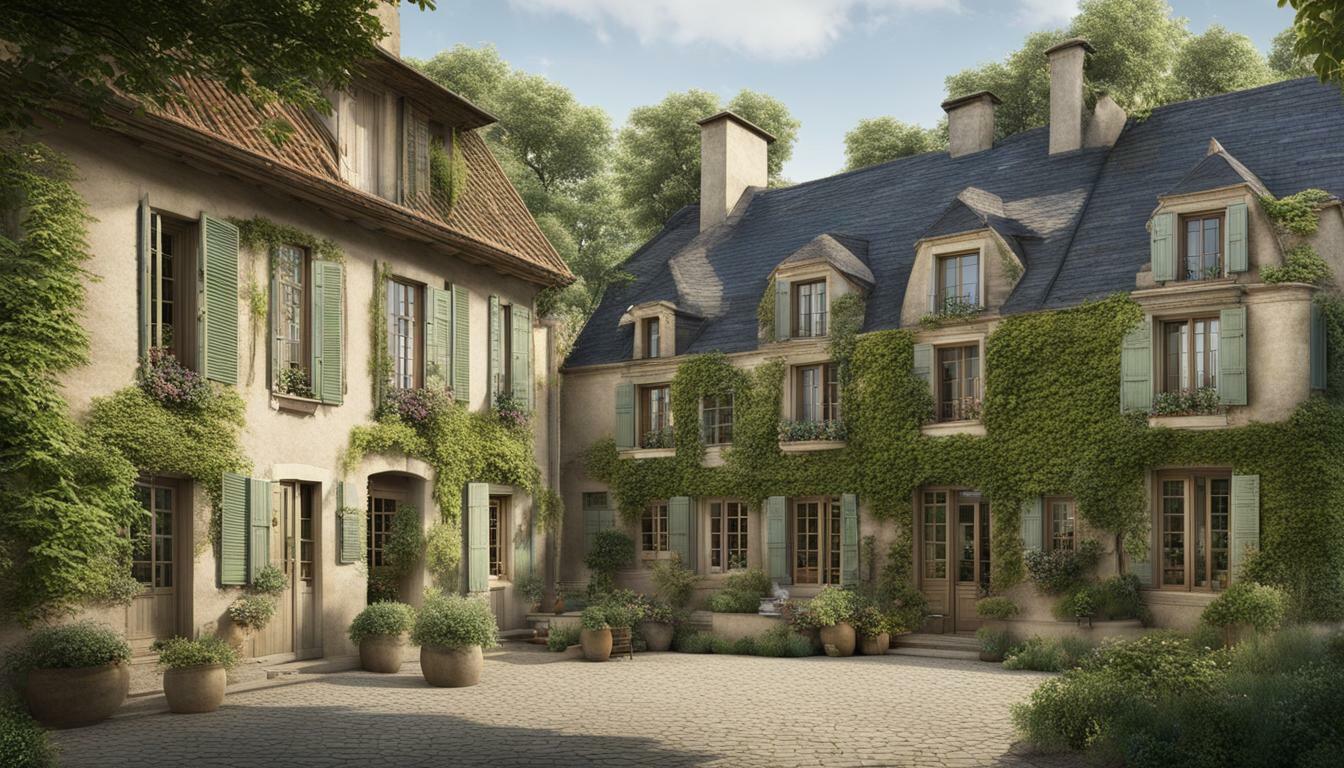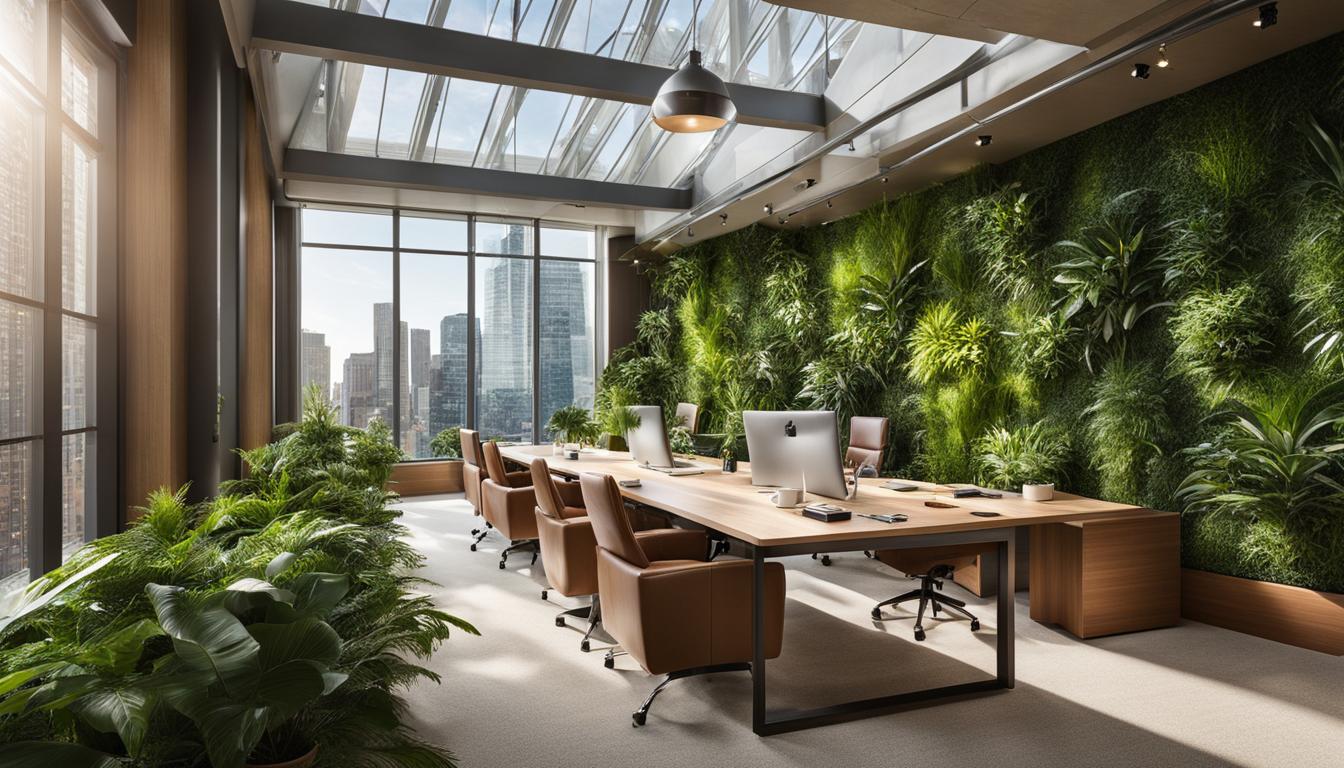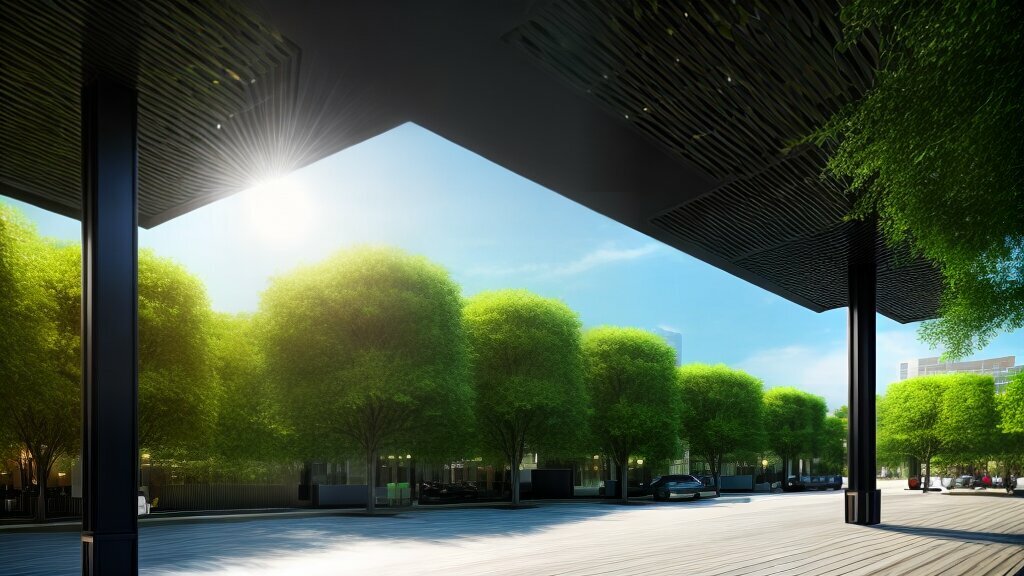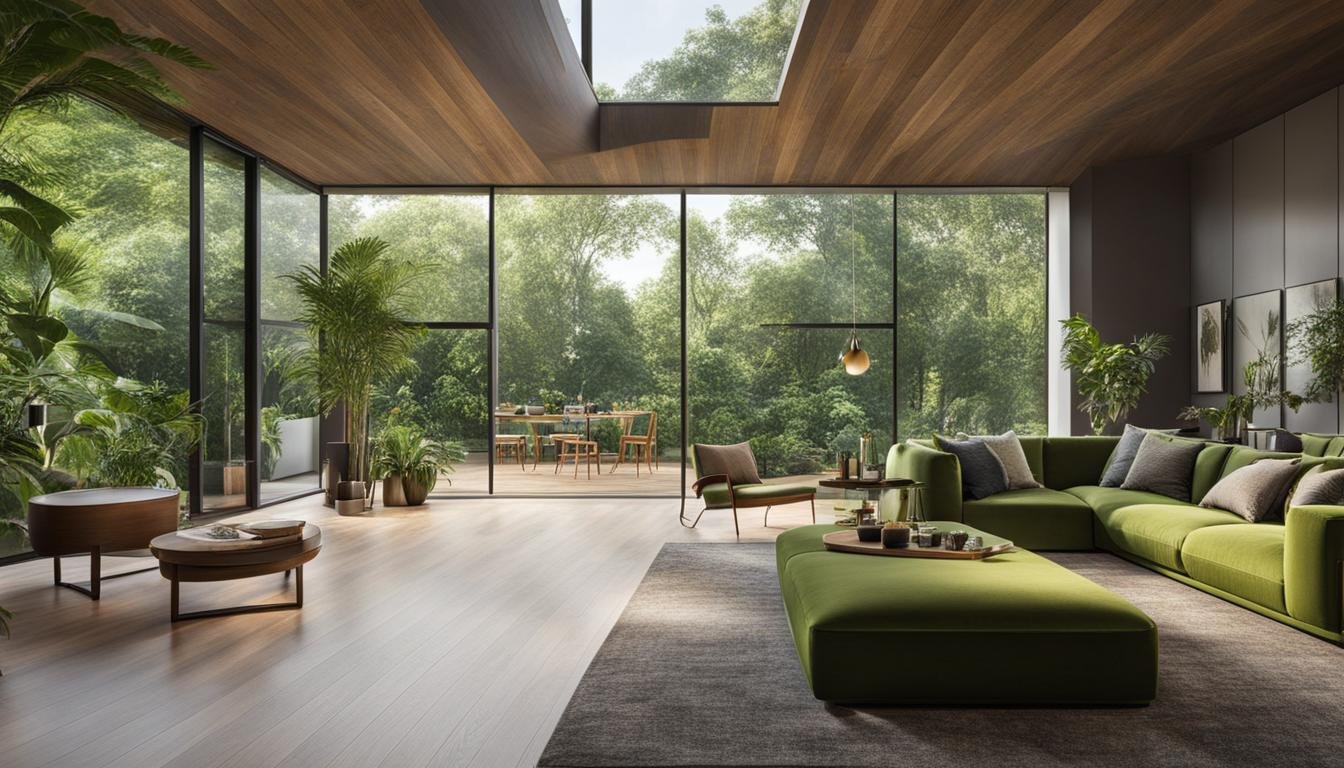Transform Your Living Space with Biophilic Home Design
Biophilic home design incorporates natural elements into our living spaces to create a connection with nature. By embracing biophilic design principles and architecture, we can enhance the well-being and serenity of our homes while promoting sustainable living.
Key Takeaways
- Biophilic home design integrates natural elements into living spaces to foster a connection with nature.
- Maximizing natural light and incorporating nature-inspired colors create a calming atmosphere.
- Using sustainable materials like bamboo and cork enhances the beauty and air quality of our homes.
- Bringing nature indoors through plants and artwork improves air quality and tranquility.
- Biophilic design principles can be applied to different settings and promote sustainability and well-being.

Embrace Natural Light and Color
Natural light plays a crucial role in biophilic home design. It not only brightens our living spaces but also has a profound impact on our mood and well-being. Maximizing natural light through larger windows, skylights, and glass doors can create a sense of openness and connection with the outdoors. Additionally, incorporating colors inspired by nature, such as soft greens and sky blues, can further enhance the biophilic experience and create a calming atmosphere in our homes.
When designing your home with biophilic principles, consider the placement and size of windows. Position them strategically to capture the most sunlight throughout the day. This not only illuminates your space but also reduces the need for artificial lighting, contributing to energy efficiency. Skylights are another great way to bring natural light into interior spaces, particularly in areas where windows may not be feasible.
In addition to maximizing natural light, incorporating colors inspired by nature is essential in biophilic design. Soft greens, reminiscent of lush foliage, can promote feelings of serenity and relaxation. Sky blues can evoke a sense of tranquility and mimic the open expanse of the sky. These colors can be incorporated through wall paint, furnishings, and decor elements, creating a harmonious and nature-inspired atmosphere in your home.
Embracing natural light and incorporating colors inspired by nature are key elements of biophilic home design. By optimizing natural light and using nature-inspired colors, we can create a harmonious and calming environment that enhances our well-being.
Incorporating Natural Elements, Natural Shapes, and Materials
In biophilic home design, the incorporation of natural elements, shapes, and materials plays a significant role in creating a harmonious and sustainable living space. By using eco-friendly and green building materials, we can not only enhance the visual appeal of our homes but also contribute to a healthier environment.
One of the key aspects of biophilic design is the use of natural materials such as bamboo, cork, sustainable timber, stone, and rattan. These materials bring a sense of warmth and natural beauty into our living spaces. Bamboo, for example, is a fast-growing and renewable resource that can be used for flooring, furniture, and decorative elements. Cork is another sustainable material that offers excellent insulation properties, making it ideal for flooring and wall coverings. By incorporating these natural materials, we can create a visual connection with nature while also promoting sustainable living.
Another important consideration in biophilic home design is the use of natural shapes and forms. Incorporating curves, flowing lines, and organic shapes into our interiors mimics the patterns found in nature and creates a more calming and inviting atmosphere. Whether it’s choosing furniture with rounded edges, incorporating curved architectural elements, or using natural-shaped decorative objects, incorporating natural shapes adds a sense of harmony and tranquility to our living spaces.

Benefits of Incorporating Natural Elements and Materials
The use of natural elements and materials in biophilic home design offers several benefits. Firstly, these materials are often more durable and long-lasting compared to their synthetic counterparts, reducing the need for frequent replacements and lowering overall waste. Additionally, natural materials such as bamboo and cork have a lower carbon footprint and require fewer resources to produce, making them more environmentally friendly choices.
Moreover, natural materials have been shown to have positive effects on indoor air quality. Synthetic materials often release volatile organic compounds (VOCs), which can contribute to poor air quality and potentially lead to health issues. On the other hand, natural materials like bamboo and cork have low VOC emissions, promoting a healthier living environment for the occupants.
By incorporating natural elements, shapes, and materials into our homes, we not only create a visually appealing and calming space but also contribute to a more sustainable and environmentally friendly lifestyle.
Bringing Nature Indoors
One of the key aspects of biophilic home design is the integration of nature-inspired interiors, creating a seamless transition between the indoors and the outdoors. By bringing elements of nature inside our living spaces, we can enhance our connection with the natural world and create a calming and rejuvenating atmosphere.
An effective way to bring nature indoors is through the incorporation of plants and greenery. Whether it’s potted plants, hanging planters, or vertical gardens, adding living plants to our homes not only adds visual interest but also improves air quality and promotes a sense of tranquility. Studies have shown that being surrounded by plants can have a positive impact on our mental health, reducing stress levels and increasing overall well-being.
In addition to plants, incorporating natural materials and textures can further enhance the biophilic experience. Wood, stone, and natural fibers such as rattan and bamboo can bring a sense of warmth and earthiness to our living spaces. From furniture to flooring, these natural elements create a visual connection with nature and add a touch of authenticity to our interiors.
Another way to create an indoor-outdoor living experience is through the use of large windows and glass doors. These not only flood our homes with natural light but also provide unobstructed views of the surrounding landscape. By opening up our living spaces to nature, we can create a seamless flow between the indoors and outdoors, blurring the boundaries and expanding our living area.
“Bringing nature indoors is not just about aesthetics; it’s about creating an environment that promotes well-being and a connection to the natural world.” – Interior Design Expert
| Nature-Inspired Interiors | Indoor-Outdoor Living | Biophilic Garden Design |
|---|---|---|
| Use of natural materials and textures | Integration of large windows and glass doors | Incorporation of planters and outdoor seating areas |
| Bringing in plants and greenery | Seamless flow between indoors and outdoors | Creating a garden oasis indoors |
| Enhancing air quality and well-being | Natural light and unobstructed views | Promoting a sense of calm and tranquility |
By embracing nature-inspired interiors, indoor-outdoor living, and biophilic garden design, we can create a living space that not only looks beautiful but also promotes our well-being. Whether it’s a small apartment or a spacious house, incorporating elements of nature into our homes can have a profound impact on our physical and mental health. So go ahead, bring nature indoors and create a sanctuary that nourishes your mind, body, and soul.

Biophilic Design in Different Settings
Biophilic design principles can be applied to various settings, allowing for sustainable home design that fosters a deep connection with nature. Whether it’s residential homes, offices, schools, or public spaces, integrating biophilic elements can create harmonious environments that promote well-being and enhance the overall experience of the users.
Biophilic Design in Residential Homes
In residential homes, biophilic design can transform living spaces into serene retreats that bring the beauty of the natural world indoors. By incorporating natural materials, such as wood and stone, and maximizing natural light through large windows and skylights, homeowners can create a sense of openness and connection with the outdoors. Additionally, indoor gardens and living walls can add a touch of greenery and improve indoor air quality, creating a tranquil atmosphere in the home.

Biophilic Design in Offices and Workspaces
Biophilic design has gained popularity in office and workspace environments, as it has been shown to improve productivity, creativity, and overall well-being. Incorporating elements such as plants, natural light, and views of nature can create a calming environment that reduces stress and enhances focus. By integrating biophilic design principles into office spaces, employers can create healthier and more inspiring work environments for their employees.
Biophilic Design in Public Spaces
Public spaces, such as parks, community centers, and museums, can benefit greatly from the incorporation of biophilic design. By creating green spaces, incorporating water features, and using natural materials, these spaces can become inviting and rejuvenating areas for people to gather and connect with nature. Biophilic design in public spaces not only enhances the aesthetics but also promotes environmental sustainability and encourages a sense of community.
| Setting | Key Biophilic Elements |
|---|---|
| Residential Homes |
|
| Offices and Workspaces |
|
| Public Spaces |
|
The Future of Biophilic Interior Design
The future of biophilic interior design looks promising, as more and more people recognize the importance of creating a sustainable and nature-inspired living environment. With a growing emphasis on eco-friendly materials, energy-efficient designs, and the integration of technology to simulate natural environments, biophilic interior design is expected to continue evolving and influencing the way we design and experience our living spaces.
One of the key aspects of the future of biophilic interior design is the focus on sustainable home design. As our awareness of environmental issues increases, homeowners are seeking ways to minimize their ecological footprint and create homes that are environmentally responsible. Biophilic interior design provides a solution by incorporating natural elements and materials that are sourced sustainably. This includes using renewable resources such as bamboo, cork, and sustainable timber in furniture and flooring, as well as utilizing green building materials that have minimal impact on the environment.
Another exciting development in the future of biophilic interior design is the use of technology to recreate natural environments within our homes. Virtual reality and augmented reality can be used to simulate outdoor spaces and bring the sights and sounds of nature indoors. This technology allows homeowners to experience the calming effects of nature even in urban environments, where access to green spaces may be limited. By creating immersive virtual environments, biophilic interior design can provide a sense of serenity and connection with nature, regardless of the physical location of the home.
Furthermore, the future of biophilic interior design will continue to prioritize nature-inspired interiors. This means incorporating colors, patterns, and textures inspired by the natural world to create a sense of harmony and tranquility. Earth tones, organic patterns, and materials that mimic nature, such as stone and wood, will be popular choices for creating a nature-inspired aesthetic. Additionally, the use of indoor gardens, living walls, and water features will become more prevalent, as homeowners seek to bring the soothing elements of nature into their living spaces.

Table: The Future of Biophilic Interior Design Trends
| Trend | Description |
|---|---|
| Sustainable Home Design | Integration of eco-friendly materials and energy-efficient designs |
| Virtual Reality and Augmented Reality | Use of technology to simulate natural environments |
| Nature-Inspired Interiors | Incorporation of natural colors, patterns, and materials |
| Indoor Gardens and Living Walls | Bringing the elements of nature indoors through greenery |
FAQs in Relation to Biophilic Home Design
Biophilic home design is a concept that incorporates natural elements into our living spaces to create a connection with nature. It is a transformative approach that enhances the well-being and serenity of our homes. Here are some frequently asked questions about biophilic home design:
1. What is biophilic home design?
Biophilic home design is a design philosophy that aims to create living spaces that foster a deeper connection with nature. It involves integrating natural elements, such as plants, natural light, and sustainable materials, into our homes to create a sense of tranquility and well-being.
2. How does biophilic home design impact well-being?
Biophilic home design has been shown to have numerous positive effects on our well-being. It can reduce stress levels, improve cognitive function, and enhance mood and productivity. By bringing nature indoors and incorporating natural elements into our living spaces, biophilic design creates a calming and rejuvenating environment.
3. What are some examples of natural elements used in biophilic home design?
There are various natural elements used in biophilic home design, including indoor plants, living walls, water features, and natural materials like wood, stone, and bamboo. These elements not only add visual interest but also promote a sense of connection with the natural world, improving the overall ambiance of our homes.
4. How can natural light be maximized in biophilic home design?
Natural light plays a crucial role in biophilic home design. To maximize natural light, larger windows, skylights, and glass doors can be incorporated into our living spaces. These architectural features not only brighten our homes but also provide a visual connection to the outdoors, creating a sense of openness and harmony with nature.
5. Are there any specific guidelines or principles to follow when incorporating biophilic design into a home?
While there are no strict rules, there are principles that can guide the incorporation of biophilic design into a home. These principles include maximizing natural light, using natural materials, incorporating indoor plants and greenery, creating a sense of connection with nature, and promoting sustainable living practices.
6. Can biophilic design be applied to small living spaces?
Yes, biophilic design can be applied to small living spaces. Even in compact areas, incorporating natural elements, such as potted plants or a living wall, can create a sense of connection with nature. Maximizing natural light and using light colors can also make small spaces feel more open and inviting.
7. Is biophilic home design suitable for all climates?
Biophilic home design can be adapted to suit different climates. In colder climates, features like large windows and skylights can maximize natural light and heat retention. In warmer climates, shading techniques, cross ventilation, and indoor plants can help regulate temperature and create a more comfortable living environment.
8. Are there any specific health benefits associated with biophilic home design?
Yes, there are several health benefits associated with biophilic home design. These include improved air quality, reduced stress levels, increased productivity, enhanced mood, and better overall well-being. The presence of natural elements and connection with nature can have a positive impact on both physical and mental health.
9. How can I incorporate biophilic design into my existing home without major renovations?
There are several ways to incorporate biophilic design into an existing home without major renovations. Adding potted plants, natural materials like wood or stone accents, and incorporating natural light through larger windows or skylights are simple ways to introduce biophilic elements. Additionally, using nature-inspired colors and incorporating artwork or photography that showcases nature can also enhance the biophilic experience.
10. Is biophilic home design more expensive than traditional interior design?
Biophilic home design does not necessarily have to be more expensive than traditional interior design. While certain sustainable materials or architectural features may come at a higher cost, there are budget-friendly alternatives available. Additionally, the long-term benefits of biophilic design, such as improved well-being and energy efficiency, can offset any initial investment.
| Question | Answer |
|---|---|
| 1. What is biophilic home design? | Biophilic home design is a design philosophy that aims to create living spaces that foster a deeper connection with nature. |
| 2. How does biophilic home design impact well-being? | Biophilic home design has been shown to reduce stress levels, improve cognitive function, and enhance mood and productivity. |
| 3. What are some examples of natural elements used in biophilic home design? | Some examples of natural elements used in biophilic home design include indoor plants, living walls, and natural materials. |
| 4. How can natural light be maximized in biophilic home design? | Natural light can be maximized through the use of larger windows, skylights, and glass doors. |
| 5. Are there any specific guidelines or principles to follow when incorporating biophilic design into a home? | While there are no strict rules, there are principles that can guide the incorporation of biophilic design into a home. |
| 6. Can biophilic design be applied to small living spaces? | Yes, biophilic design can be applied to small living spaces. |
| 7. Is biophilic home design suitable for all climates? | Biophilic home design can be adapted to suit different climates. |
| 8. Are there any specific health benefits associated with biophilic home design? | Yes, there are several health benefits associated with biophilic home design. |
| 9. How can I incorporate biophilic design into my existing home without major renovations? | There are several ways to incorporate biophilic design into an existing home without major renovations. |
| 10. Is biophilic home design more expensive than traditional interior design? | Biophilic home design does not necessarily have to be more expensive than traditional interior design. |
Conclusion
In conclusion, biophilic home design presents a remarkable opportunity to create living spaces that not only enhance our well-being but also promote sustainable living and eco-friendly practices. By incorporating natural elements, maximizing natural light, and bringing nature indoors, we can establish a harmonious and tranquil environment that fosters relaxation, productivity, and overall happiness.
Embracing the principles of biophilic design allows us to connect with nature and experience the beauty of the natural world within the confines of our own homes. By choosing sustainable materials, maximizing natural light and ventilation, and incorporating nature-inspired interiors, we can create living spaces that not only benefit our well-being but also contribute to a more environmentally conscious lifestyle.
Biophilic home design offers a transformative approach to sustainable living, enabling us to create nature-inspired living spaces that go beyond mere aesthetics. By embracing this design philosophy, we can foster a deeper connection with nature and create a sanctuary within our own homes, where we can thrive and find solace amidst the chaos of modern living. Ultimately, biophilic home design allows us to live in harmony with our natural surroundings while enjoying the benefits of a comfortable and nurturing living space.
FAQ
What is biophilic home design?
Biophilic home design is an approach that incorporates natural elements into living spaces to create a connection with nature. It involves integrating biophilic design principles and architecture to enhance well-being and serenity in our homes.
How does biophilic home design impact well-being?
Biophilic home design has a positive impact on well-being by fostering a deeper connection with nature. It promotes relaxation, productivity, and overall happiness. The use of natural elements, natural light, and greenery creates a harmonious and peaceful environment.
What are some examples of natural elements used in biophilic home design?
Some examples of natural elements used in biophilic home design include bamboo, cork, sustainable timber, stone, and rattan. These materials bring a sense of warmth and natural beauty into living spaces.
How can natural light be maximized in biophilic home design?
Natural light can be maximized in biophilic home design by incorporating larger windows, skylights, and glass doors. This creates a sense of openness and connection with the outdoors, enhancing the biophilic experience.
Are there any specific guidelines or principles to follow when incorporating biophilic design into a home?
Yes, there are specific principles to follow when incorporating biophilic design into a home. These include maximizing natural light, using natural materials, incorporating greenery, and creating a visual connection with nature.
Can biophilic design be applied to small living spaces?
Yes, biophilic design can be applied to small living spaces. Even in limited areas, incorporating natural materials, maximizing natural light, and adding small indoor plants can create a sense of connection with nature.
Is biophilic home design suitable for all climates?
Yes, biophilic home design is suitable for all climates. It can be adapted to different weather conditions and environments. The principles of biophilic design, such as natural light and materials, can be applied in various settings.
Are there any specific health benefits associated with biophilic home design?
Yes, biophilic home design has specific health benefits. It improves air quality, promotes relaxation, reduces stress, and enhances overall well-being. The presence of greenery, natural light, and natural materials contribute to a healthier living environment.
How can I incorporate biophilic design into my existing home without major renovations?
You can incorporate biophilic design into your existing home without major renovations by adding indoor plants, using natural materials for decor, maximizing natural light through window treatments, and displaying nature-inspired artwork.
Is biophilic home design more expensive than traditional interior design?
Biophilic home design can be tailored to suit different budgets. While some aspects, such as eco-friendly materials, may have higher upfront costs, there are cost-effective ways to incorporate biophilic design principles into your home.









26 Design Tips To Steal From Finland
10 months ago[…] © Constructive Voices […]